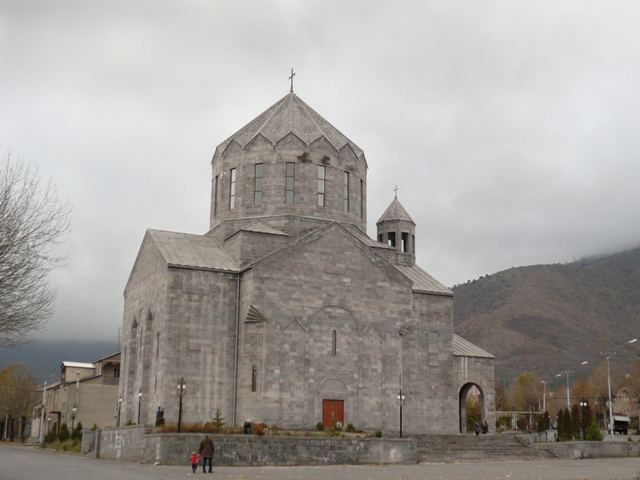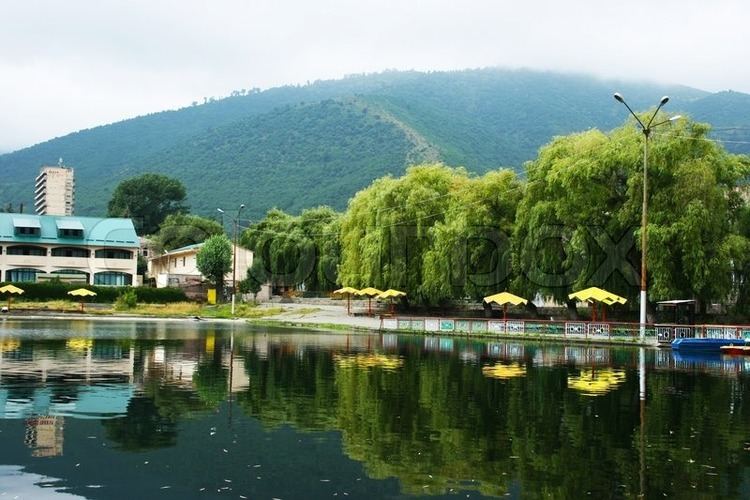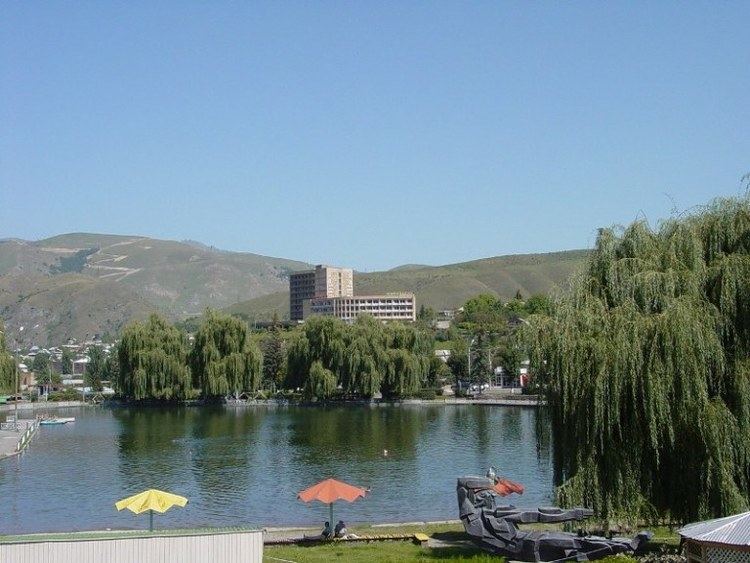Country Population 104,825 (2009) Founded 1828 | Elevation 1,425 m Area 25.1 km2 Mayor Samvel Darbinyan | |
 | ||
Map of Vanadzor
Vanadzor (Armenian: Վանաձոր [vɑnɑˈdzɔɾ]), is the third-largest city in Armenia and the capital of the Lori Province in the northern part of the country. It is located around 128 kilometres (80 miles) north of the capital Yerevan. As of the 2011 census, the city had a population of 86,199, down from 148,876 reported at the 1979 official census.
Contents
- Map of Vanadzor
- Gagik tsarukyans wife javahir tsarukyans visit to vanadzor
- Jimik kafyan vanadzor
- Etymology
- History
- Geography and climate
- Population
- Religion
- Culture
- Transportation
- Industry
- Tourism
- Education
- Football
- Other sports
- Twin towns Sister cities
- References

The city is in a picturesque setting, with an attractive planned town centre. Mostly crumbling Soviet-era chemical factories dominate much of the valley below the city.

Gagik tsarukyans wife javahir tsarukyans visit to vanadzor
Jimik kafyan vanadzor
Etymology

Vanadzor was known as Gharakilisa (Karakilisa) at its foundation during the days of the Russian Empire. Following the Sovietization of Armenia, the city was named Kirovakan (Armenian: Կիրովական) in 1935, after the Russian Bolshevik leader Sergey Kirov. After the independence of Armenia, Kirovakan was renamed Vanadzor in 1992.

Vanadzor is composed of two words, Van (Armenian: Վան) referring to the historic Armenian city of Van in modern-day Turkey, and dzor (Armenian: ձոր), meaning valley in Armenian. Thus, the name of the city means the "valley of Van".
History
The area of present-day Vanadzor has been settled since the Bronze Age, based on the tombs and other historic remains found on the nearby hills of Tagavoranist and Mashtots. During the ancient Armenian kingdoms, the area was considered as part of the Tashir canton of Gugark; the 13th province of the Kingdom of Armenia (Armenia Mayor), until the end of the Artaxiad Dynasty's rule over Armenia in the 1st century AD. Later, the region was ruled by the other Armenian dynasties of the Arsacids and the Bagratunis. By the end of the 10th century, the area became part of the Kingdom of Lori (Kingdom of Tashir-Dzoraget) until the beginning of the 12th century. With the invasion of the Seljuk Turks, the region became under the rule of the Great Seljuk Empire. The settlement was called Gharakilisa (meaning the black church in Turkic) by the Seljuks possibly as early as the 13th century, from the black-stoned Armenian church of the Holy Mother of God, on the nearby hill.
In 1801, the entire region of Lori became part of the Russian Empire along with the Georgian state, a fact that made Lori one of the strategically important territories for the Russian defensive forces on the border against Persia. In 1826, the settlement of Gharakilisa was entirely destroyed by Hasan Khan during the Russo-Persian war. In 1828, the Russians founded a new town to become a major centre for the deployment of their troops during the Russo-Turkish War of 1828–29. According to Khachatur Abovian, the population of Gharakilisa was not more than 600 by the end of the 1820s, mainly migrants from Yerevan. In 1849, it became part of the Erivan Governorate within the Russian Empire. Under the new administrative status, Gharakilisa was flooded with many hundreds of migrating Armenian families from Kars, Ardahan and Western Armenian cities of Karin and Daroynk).
The town enjoyed considerable uplift through the opening of the railroad towards Tbilisi in 1899. The vicinity of the town had become site of the Battle of Karakilisa in May 1918, when General Tovmas Nazarbekian's outnumbered troops, led by Garegin Nzhdeh successfully defended the region from the invading Turkish Army, pushing them back just few days after the crucial Armenian victory in the Battle of Sardarapat, thus allowing the Republic of Armenia to come into existence. On the North side of the Spitak-Vanadzor highway, about 2 km (1 mi) West of the city, there is a little shrine in the ruins of a church, site of a planned monument to that battle.
However, after 2 years of brief independence, Armenia fell under the Soviet rule. The first city development plan of Gharakilisa initiated by architects Karo Halabyan, Mikayel Mazmanyan and Gevork Kochar was adopted in 1929–1930. Under the new plan, the town was enlarged towards the eastern and western parts. In 1935, the Soviets renamed the city Kirovakan after the Bolshevik leader Sergey Kirov. In 1939, the new remodeling plan of the city created by architects N. Zargaryan and A. Minasyan was introduced to create an industrial district and a summer-resort area. The centre of the city was redeveloped during the 1950s. The central town square named after Sergey Kirov (now Hayk Square) was opened along with the surrounding government and administrative buildings.
After the independence of Armenia, Kirovakan was renamed Vanadzor after the Vanadzor River that flows through the city.
Vanadzor, along with Gyumri and Spitak (25 km (16 mi) west), suffered a considerable amount of damage from the 1988 earthquake when 564 residents died in the city. Unlike the two other cities, the majority of buildings in Vanadzor were unscathed from the earthquake.
Geography and climate
Vanadzor, the capital of Lori Province, is located 128 km (80 mi) north of Yerevan and 64 km (40 mi) east of Gyumri.
At an average height of 1,350 metres (4,430 feet) above sea level, Vanadzor is located in the valley of Pambak River, on the point where the rivers of Tandzut and Vanadzor join the Pambak river. The city, is surrounded with the over 2,500-metre-high (8,200-foot) mountains of Bazum and Pambak. The southern and eastern regions are densely forested while to the north and west are only covered with bushes and plants.
The climate of Vanadzor is characterized with cool summers and relatively mild winters. The average temperature in winter is −4.2 °C (24.4 °F), while in summer it reaches up to 20 °C (68 °F). Vanadzor's climate is classified as humid continental (Köppen climate classification Dfb). The amount of precipitation is around 650 mm (25.6 inches).
The Vanadzor Botanical Garden located to the southwest of the city is one of the 5 botanical parks within the Republic of Armenia.
Population
The population of Vanadzor has grown gradually since 1849, after becoming part of the Yerevan Governorate.
The population of Vanadzor increased significantly after the Second World War, when Stalin allowed open immigration to the Armenian Soviet Socialist Republic with the promise of a better life in the historical homeland. More than 150,000 Armenians from different parts of Europe and the Middle East, most being survivors of the Armenian Genocide, immigrated and settled in Vanadzor (Kirovakan). Due to the harsh conditions imposed by the Soviets' intelligence and Ministry of the Interior, many of the immigrants were sent to labour camps in Siberia and elsewhere. The reason for such disrespectful treatment towards the Armenian immigrants was because almost all were more educated than the local community, spoke more than 3 languages, and some were open believers of Armenian major religious sects (Apostolic, Evangelical and Catholic) which was considered a threat to national security by the Stalinist Government.
Despite the difficulties more Western Armenians immigrated to Kirovakan in following years.
Most of the immigrants left Vanadzor and went back to Cyprus, Lebanon, Greece, France and the United States. Today there are approximately 2000 Western Armenian settlers living in Vanadzor, most of whom still use the Western Armenian dialect at home.
The majority of the city's population are ethnic Armenians with minor Russian, Ukrainian and Greek communities.
Here is the population timeline of Vanadzor since 1831:
Religion
The majority of the population belongs to the Armenian Apostolic Church. Vanadzor is the seat of the Diocese of Gougark of the Armenian Apostolic Church, serving the population of Lori province.
As of 2016, The city is home to 4 churches and 2 chapels:
Culture
Vanadzor has several archaeological sites including the nearby Mashtots hill which is home to many remains from the 4th millennium BC. The Lori-Pambak archaeological museum opened in 1938 is dedicated to the history and ethnography of Gugark region. It currently has a collection of around 34,000 pieces.
Vanadzor is the cultural centre of Lori Province and northeastern Armenia. The Vanadzor House of Culture named after Charles Aznavour is one of the largest centres in Armenia. The Eduard Kzartmyan school of music is a prominent art school founded in 1934. The Vanadzor fine art museum is operating since 1974, while the house-museum of writer Stepan Zoryan is operating since 1990.
The city is home to many theatres including the Bohem Chamber Theatre of Vanadzor, Vanadzor Musical Theatre, Vanadzor Drama Theatre named after Hovhannes Abelyan, and Vanadzor Puppet Theatre. Other famous art ensembles of Vanadzor include Horevel Folke Dance Ensemble (founded in 1958), Vanadzor Chamber Music Choir (1989), and Vanadzor Chamber Orchestra (1993).
Vanadzor has also produced many famous hard rock bands including Lousnelius, Lav Eli and Vordan Karmir.
As of 2016, the city is home to 4 public libraries as well as 4 children's libraries.
Transportation
The city is connected with other major cities of Armenia with a railway and a motorway. The M-6 Motorway that connects the capital Yerevan with the Georgian capital Tbilisi passes through Vanadzor. The city is connected with Tavish Province to the east through the M-8 Motorway.
Vanadzor has a railway station that also connects the city with northern and central Armenia. In April 2012, the Zamarlu bridge was opened at the Vanadzor-Ayrum railroad section to secure a safe passage of the trains on this segment. Currently, the Vanadzor-Fioletovo railroad section is under construction within the frames of the Armenian railway development programme.
The nearest airport to the town is the Stepanavan Airport (44 km (27 mi) north), currently under renovation.
Industry
The city of Vanadzor is the main industrial centre of the province. The industry of the city is quite diversified with many firms specialized in garment manufacturing, chemical products, building materials, and dairy products. The largest garment manufacturers of the city are the "Dav-Gar" garment factory founded in 1962, the Darbbag's Sewing Factory founded in 1977 (privatized in 1996), the "Sarton" Sewing Factory founded in 1990, "Ruz-Dan" garment factory founded in 2000. The largest chemical plants of Vanadzor include the "Vanadzor ChimProm" founded in 1929, the "Gipk" enterprise for polymeric materials founded in 1967, and the "Gary Group" for polymeric materials founded in 1998. The "Beton" enterprise founded in 1988, the "Bionik" plant founded in 2004, and the "Karaberd" plant are specialized in building materials. The "DIET LLC", the "K&K" factory, and the "Katnagorts" plant are specialized in dairy products. Othe major industrial plants of Vanadzor include the "Ardvin" electromechanical plant founded in 1956, the "Gems De Luxe" precious stone processing enterprise founded in 1996, and the "Jerutsogh" factory for heating equipments.
Many small plants for the production of building materials, mainly tufa, basalt and clay are also operating in Vanadzor.
The city is home to the Vanadzor Thermal Power Plant opened in 1961.
Tourism
Vanadzor is a resort centre in northern Armenia due to its mild climate, clean air and mineral springs. Many hotels and spa resorts are built in the city and the nearby countryside.
The city is connected with other major cities of Armenia with a railway and a motorway.
The Armenia Vanadzor Spa and Hotel Complex is among the most significant resorts since the Soviet times.
Education
Vanadzor is home to many educational institutions serving the population of the city and the residents of Lori and Tavush provinces.
The following educational institutions are currently operating in the city:
On 29 October 2016, the Vanadzor Technology Center was opened in the city in an attempt to promote the business and technology environment in the entire region.
As of 2009, 6 technical intermediate colleges, 30 public education schools and 20 nurseries are operating in the city.
Football
Football is popular in Vanadzor. The currently defunct football club Lori Vanadzor founded in 1936, was one of the oldest football clubs in Armenia. After the independence of Armenia, the team represented the city in domestic competitions until 2006 when was dissolved due to financial difficulties.
The largest sport venue in the city is the Lori Stadium with a capacity of 5,000 spectators. It is mainly used for football matches. A renovation plan was scheduled in order to redevelop the stadium to meet the requirements of the UEFA.
The FFA Vanadzor Football Academy opened its doors on 29 October 2016. It is home to 3 natural grass and 1 artificial turf regular-sized pitches.
In 2017, a new football club named Lori was founded in 2017 by Tovmas Grigoryan; a native businessman of Vanadzor. The club made its debut at professional football through the 2017–18 Armenian First League competition.
Other sports
Futsal is among the popular team sports in the city. The VSU futsal team plays at the Armenian Futsal Premier League. The Armenia Sports Arena of Vanadzor is the home venue of the team.
Handball and volleyball are also popular in Vanadzor. Many sport schools operate in the city under the supervision of the municipality, including the schools of swimming, athletics, weightlifting, chess, artistic gymnastics, table tennis and badminton.
Winter sports are also practiced in Lori Province. A ski resort near Vanadzor operates during the snowy season, generally extending between December and March.
Twin towns – Sister cities
Vanadzor is twinned with:
